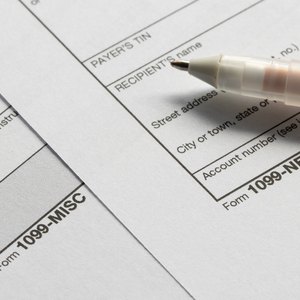
Tracking down all the necessary forms you'll need at tax time can be frustrating and exhausting. People receive W-2 Forms from their employers after the first of the new year, showing what they earned and how much in taxes was withheld from their pay. But you'll probably also receive one or more 1099 forms if you earned extra income during the year, or if you're an independent contractor.
What Are 1099 Forms?
Form 1099 is an information return. It's used to report income payments other than salaries and wages that were paid during the tax year. The payor of that income must submit a Form 1099 to the IRS and send a copy to the recipient of the money as well. The recipient must report this income to the IRS on their tax return.
You should receive 1099s for any earnings you received during the tax year subject to certain thresholds. For some types of payments, a payor is only required to issue most 1099 forms if they paid $600 or more to a taxpayer during the tax year. The $600 threshold doesn't apply to each individual payment. It's the total paid by that entity over the course of the year. You'll receive one if someone paid you $300 in July and $350 in November, even though neither payment exceeded $600. They collectively amount to $650.
Failure to receive a 1099 doesn't release you from the obligation to report the income you received. You’re still expected to report all the money you've earned, even if it was paid in cash or if you don't receive a 1099 for it. And, if it was less than $600, even though a 1099 is not required, you must still report that income.
Read More: How Does a 1099 Form Work?
Where to Get 1099 Forms
You should have all the appropriate tax forms handy at tax time if you run a business. Your accountant or tax preparation software should have Forms 1099 available, but you can also print out the current version of each 1099 form at the IRS website.
As for those who expect to receive 1099 forms for income earned, you can still report the earnings on your tax return without the form if you kept good records so you know how much you were paid. You don't have to provide the form to the IRS when you file your return because the payee has already submitted a copy to the agency. You simply need the information to prepare your tax return.
Taxes are rarely withheld from 1099 income, so you don't have to concern yourself with how much was subtracted from your earnings and submitted to the IRS on your behalf. But you'll definitely want to reach out to the payee if you don't receive a 1099 and you think taxes might have been withheld. You'll need to know just how much you've already paid through withholding.
Income and Distribution 1099 Forms
Some 1099 forms relate to types of non-employee income earned during the tax year. The $600 threshold applies to these forms.
As the name suggests, Form 1099-MISC covers miscellaneous income. This includes rents and prizes, as well as some more unusual sources such as fishing boat proceeds and crop insurance proceeds. Form 1099-MISC once reported non-employee compensation as well, but the IRS split this income off and gave it its own information form in 2020.
Non-employee compensation is now reported on Form 1099-NEC. Self-employed taxpayers, independent contractors and freelancers will receive Form 1099-NEC instead of Form 1099-MISC from any individual or entity who paid them $600 or more. This can be tricky, however, if you're self-employed and provide services to the public. Maybe you repair computers or other electronic equipment. Your customer or client is most likely not going to send you a 1099 form if they paid you $1,000 over the year to keep their computers up and running. You'll need good records in this case to accurately report how much you earned.
You'll receive a Form 1099-R if a retirement or profit-sharing plan issued you payments of $10 or more during the tax year. These forms relate to distributions from IRAs, annuities and insurance contracts.
Form 1099-SA reports distributions from your health savings account or medical savings account. Both are savings accounts that let you use pretax money to pay medical expenses.
You’ll be issued a Form 1099-G if you received certain government payments during the tax year. These might include unemployment compensation, state or local income tax refunds and taxable grants. The exception is Social Security payments. You'll receive an SSA-1099 for this income. Special rules apply to Social Security retirement benefits, so you won't have to pay tax on all you received. And supplemental security income isn't taxable at all.
Banking and Investment 1099 Forms
You might receive income during the year if you have an interest-bearing savings account or you invest some of your money. You’ll receive 1099 forms at tax time to guide you in reporting this income on your tax return. The 1099-INT is probably the most common of this type of form. It documents interest you received on your savings account or other account balances. You might not receive this form unless you were paid more than $10 in interest during the tax year, but again, you still have to report the income.
You’ll receive a 1099-DIV at tax time if you hold investments. This covers dividends or other distributions you received from investment accounts.
Read More: What is Form 1099-NEC?
Forms for Businesses
Some 1099 forms are specific to businesses, even if yours is a side gig and not a full-blown corporation. Form 1099-K reports credit card transactions you might have received and payments that are made through third-party networks such as eBay or PayPal. So yes, you may receive one or more if you sell homemade products only. Form 1099-K applies if you received payments from customers who used debit cards, credit cards or stored-value cards.
The reporting threshold used to be significantly higher for this form of 1099: gross payments of $20,000 and more than 200 transactions in the course of the tax year. The American Rescue Plan Act of 2021 changed this. This reporting threshold is also $600 regardless of the number of transactions as of Jan. 1, 2022.
Large corporations will file Forms 1099-CAP and issue copies to their shareholders if there’s some type of change in the corporate structure during the tax year. Form 1099-C reports cancellation of debt. Businesses must file Form 1099-C with the IRS and issue a copy to the debtor if a debt of $600 or more is forgiven or canceled during the tax year. Maybe you went through tough financial times and you defaulted on a credit card. The lender forgave the balance, declining to pursue you for it in court. This, too, is taxable income, according to IRS rules.
Read More: What Is the Maximum Earnings Before Issuing a 1099?
Ensuring Tax Compliance
You might bring in extra income through a variety of ways over the course of the tax year. It's almost always taxable, and you should receive a 1099 from the payor if it exceeds these thresholds. The best way to stay out of trouble with the tax guys is to track your income from start to finish so you're not entirely reliant on receiving these forms when you begin preparing your tax return.
Your bank’s reporting features can help a great deal in this regard. Consider setting up a separate bank account so that all your side income is separate from your regular earnings. You'll have a record of all deposits made during the tax year.
References
- IRS: Am I Required to File a Form 1099 or Other Information Return?
- IRS: Forms, Instructions & Publications
- IRS: More in Help
- IRS: About Form 1099-NEC, Nonemployee Compensation
- IRS: About Form 1099-R, Distributions From Pensions, Annuities, Retirement or Profit-Sharing Plans, IRAs, Insurance Contracts, etc.
- IRS: About Form 1099-SA, Distributions From an HSA, Archer MSA, or Medicare Advantage MSA
- IRS: About Form 1099-G, Certain Government Payments
- IRS: About Form 1099-INT, Interest Income
- IRS: About Form 1099-DIV, Dividends and Distributions
- IRS: Understanding Your Form 1099-K
- IRS: About Form 1099-C, Cancellation of Debt
- IRS: Reporting Payments to Independent Contractors
- IRS: About Form 1099-MISC, Miscellaneous Income
- IRS: Social Security Income
Writer Bio
Stephanie Faris has written about finance for entrepreneurs and marketing firms since 2013. She spent nearly a year as a ghostwriter for a credit card processing service and has ghostwritten about finance for numerous marketing firms and entrepreneurs. Her work has appeared on The Motley Fool, MoneyGeek, Ecommerce Insiders, GoBankingRates, and ThriveBy30.
